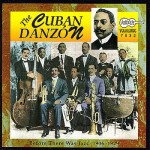“If music is life, the danzón is Joy”
Julia is a telephone operator in Mexico City who divides his life between work, her daughter and Danzón, a musical framework for it is part of everything. Every Wednesday, Julia looks on the runway at “Salon Colonia” Carmelo arm, her dance partner. When after three nights without appearing Carmelo disappears, she vows to go look at the city of Veracruz, not knowing that this trip will change your life in this short summary of the film of the production management Mexican Maria Novaro, who takes the sensual rhythm, Danzon, as musical frame to highlight in his opinion a new role in the lives of Mexican women and the lilting rhythm that arrived in Mexico 130 years ago to stay.
México and Cuba
Mexico has a long strife with Cuba on the paternity of the Danzón.
Unlike many Caribbean rhythms and dances the Danzon has a date of birth: Matanzas, Cuba, January 1, 1879, place and day the Cuban Miguel Faílde debuted what is considered the first Danzón, “Simpson heights.”
A year after coming through the port of Progreso, in Merida, Veracruz and Mexico City, where you turn on the entire Mexican Republic.
A Mexican woman, Julia
As a gentle and refined instrument of femininity in his original score danzón takes in the film version of the production Novaro promoting popular musical genre in Mexico reopening of numerous appetite rhythmic dance and interpret sites, although the lives of women of “Danzon” revolves around men the film is more about establishing ties them together as their relationships with men themselves. For Julia, who considered the foremost dance danzón life activity, the search for Carmelo and his eventual meeting with other characters in the film, will take again into her femininity that demystifies the roles commonly attributed to women in Mexico where their role has gained enormous importance underlined by the film production Danzon, the most feminine of all Mexican films of all time, according to critics.
With Julia’s return to his people without finding a partner, in Danzon women who prudently changed that view is the separation of the bodies as stipulated in the original rules of the dance and the return of Carmelo that final meeting between the two bodies and a long look that expose their own instincts and realities.
I International Congress of the Danzón
In the last day of March 2009 was held in Mexico City at the Plaza Tolsa and The Citadel, where traditional dance is practiced, the First International Congress Danzon, with the participation of dancers, filmmakers and specialists from Colombia, Cuba, Holland, Italy, Venezuela, Guatemala and Mexico. Show ended with a Grand Gala at the Grand Forum Danzonera (Metro Taxqueña) where Acerina intervened and Danzonera, Three Generations, Dimas, New Danzonera and other well-known orchestras and performers of danzón.
As every year, in the latter, the Fourth Edition of the International Congress Danzon, was held from 13 to 16 April 2012 with artists and guests from various countries and as always was an embodiment of pride for all Mexicans and their many participants.
The danzón, a genre that undoubtedly endure despite our age full of “scandals” music, a rhythm that will survive despite this tidal wave of technology and globalization.
Source: ElDanzón/ArnoldoVarona/InternetPhotos/TheCubanHistory.com
Danzon:unregaloorgullodeMexico/The Cuban History/ Arnoldo Varona, Editor
“Si la música es la vida, el danzón es la alegría”
DANZON: UN REGALO ORGULLO DE MEXICO
Julia es una telefonista en Ciudad de México que divide su vida entre el trabajo, su hija y el danzón, un marco musical que constituye para ella parte de su todo. Cada miércoles, Julia se luce en la pista del “Salón Colonia” del brazo de Carmelo, su pareja de baile. Cuando después de tres noches sin presentarse Carmelo desaparece, la mujer toma la determinación de ir a buscarlo a la ciudad de Veracruz, sin saber que ese viaje cambiará su vida en este pequeño resumen de la gestión fílmica de la productora mexicana María Novaro, que toma al sensual ritmo, el danzón, como armazón musical para destacar en su opinión un nuevo papel en la vida de la mujer mexicana y ese cadencioso ritmo que llegára a México hace 130 años para quedarse.
México y Cuba
México tiene una vieja porfía con Cuba sobre la paternidad del danzón.
A diferencia de muchos ritmos y danzas caribeñas el danzón tiene una fecha de nacimiento: Matanzas, Cuba, enero 1, 1879, lugar y día en que el cubano Miguel Faílde debutó lo que se considera el primer danzón: “Las alturas de Simpson”.
Un año después entraba por el puerto de Progreso, por Mérida, por Veracruz y Ciudad de México, desde donde prende a toda la República Mexicana.
La mujer mexicana en Julia
Como un suave y refinado instrumento de feminidad en su partitura original el danzón toma en la versión fílmica de la productora Novaro la promoción del popular género musical abriendo nuevamente en México el apetito rítmico de numerosos sitios para bailarlo e interpretarlo; aunque la vida de las mujeres de “danzón” gira alrededor de los hombres el filme se refiere más a los lazos que establecen ellas entre sí que a sus relaciones con los hombres mismos. Para Julia, que considera bailar danzón la más destacada actividad de su vida, la búsqueda de Carmelo y su eventual encuentro con otros personajes del filme, le llevará de nueva cuenta a su feminidad que desmitifica los roles que comúnmente se les atribuyen a la mujer en México donde su papel ha adquirido enorme importancia acentuado con la producción de la película Danzón, el más femenino de todos los filmes mexicanos de todos los tiempos, según los críticos.
Con el regreso de Julia a su pueblo sin haber encontrado a su pareja, en Danzón la mujer cambia esa visión que prudentemente ve la separación de los cuerpos como lo estipulan las reglas originales del baile y con el regreso de Carmelo ese final encuentro de ambos cuerpos y el de una larga mirada que dejan al descubierto sus propios instintos y realidades.
Primer Congreso Internacional del Danzón
En los últimos días del mes de marzo de 2009 se celebró en Ciudad de México, en la Plaza Tolsá y en La Ciudadela, lugares donde tradicionalmente se practica el baile, el I Congreso Internacional del Danzón, con la participación de bailarines, cineastas y especialistas originarios de Colombia, Cuba, Holanda, Italia, Venezuela, Guatemala y México. Espectáculo que terminó con una Gran Gala Danzonera en el Gran Forum (Metro Taxqueña) donde intervinieron Acerina y su Danzonera, Tres Generaciones, Dimas, Nueva Danzonera y otras conocidas orquestas e intérpretes del danzón.
Como anualmente, en éste último, la IV Edición del Congreso Internacional del Danzón, se celebró desde el 13 al 16 de abril de 2012 con artistas e invitados de varios paises y como siempre fué una realización de mucho orgullo para todos los mejicanos y sus muchos participantes.
El danzón, género que indudablemente perdurará pese a nuestra época cargada de “escándalos” musicales, un ritmo que sobrevivirá a pesar de esa gigantesca oleada de tecnología y globalización.
Source: ElDanzón/ArnoldoVarona/InternetPhotos/TheCubanHistory.com
Danzon:unregaloorgullodeMexico/The Cuban History/ Arnoldo Varona, Editor



 Danzón: a Gift Pride of México
Danzón: a Gift Pride of México

